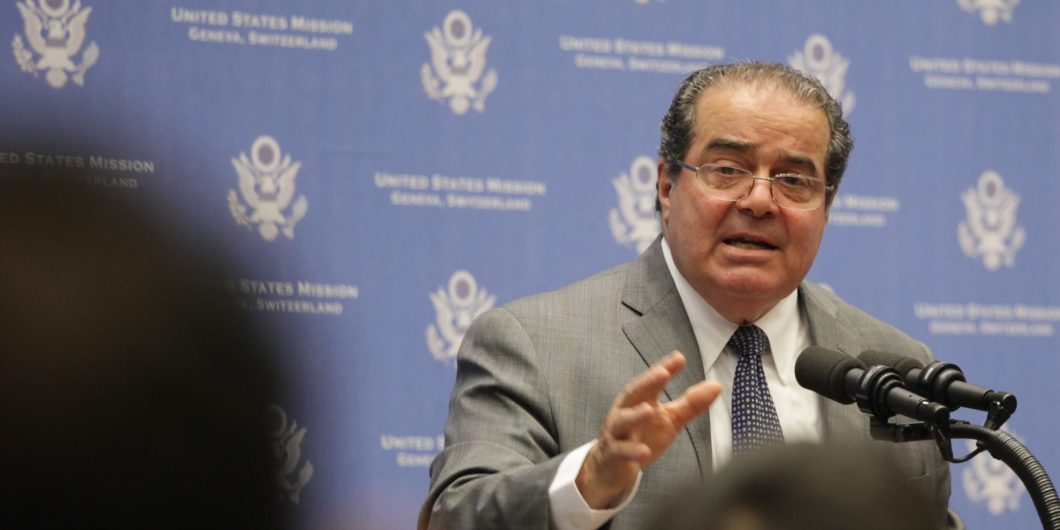The Supreme Court can be divided into three camps, two of which have claims to be originalist.
A Scalia Digest
Perhaps unfairly, most jurists are quickly forgotten when they leave the bench. Some are remembered only in infamy: the “Four Horsemen” who blocked the New Deal early on; Roger Taney for the Dred Scott decision; Harry Blackmun as the unlikely author of Roe v. Wade, and so forth. Justices with a literary flair tend to linger in the public mind, explaining the enduring influence of Oliver Wendell Holmes and Robert Jackson, among a handful of others.
History’s judgments can be fickle—even random. A single footnote (in Carolene Products) ensures Harlan Fisk Stone’s fame, a single dissent (in Plessy v. Ferguson) sanctifies John M. Harlan, and Potter Stewart’s jurisprudential legacy will likely be defined by a single phrase (“I know it when I see it”) from his concurring opinion in Jacobellis v. Ohio. Some justices are associated with scandal (e.g., Abe Fortas), and others are known mainly for their extrajudicial exploits (e.g., William O. Douglas). Most—like David Souter—simply disappear from public consciousness altogether.
A small number stand out as jurisprudential giants: John Marshall, William Brennan (although Earl Warren often gets the credit), and a debatable assortment of runners-up—Story, Field, Brandeis, Hughes, Frankfurter, Harlan II, Rehnquist, Thomas (con law scholars will argue vociferously about the rankings, but the list is short in any event). One thing is sure: Antonin Scalia is one of the greatest of all time, for all the right reasons. He will never be forgotten. A new book, The Essential Scalia, edited by a pair of former Scalia clerks (Sixth Circuit Judge Jeffrey Sutton and Ed Whelan), illustrates why.
Scalia’s judicial record, spanning 30 years on the Court, was massive, consisting of 870 opinions (281 majority opinions, 315 concurrences, and 274 dissents). In addition, he wrote important scholarly publications, in particular a 1989 article in the University of Chicago Law Review entitled “A Rule of Law as a Law of Rules” (delivered as the Oliver Wendell Holmes, Jr. Lecture at Harvard Law School) and the book A Matter of Interpretation in 1997. Moreover, until his untimely death in 2016, Scalia gave many speeches, to assorted audiences on a variety of subjects. In 2011, he even testified before the Senate, where he joked that his “pilgrimage” on the Court had started, referring to his unanimous (98-0) confirmation in 1986 as the first Italian-American justice.
In The Essential Scalia, Sutton and Whelan have done a yeoman’s job of culling the highlights from Scalia’s work and organizing them into themed categories. The topics include originalism, textualism, constitutional structure, and administrative law, and cover a diverse array of Supreme Court cases. Each chapter begins with a brief preface by the editors, providing relevant context, and each entry is introduced with a brief description of its source and background. Most impressively, in the interest of including a broad sample of Scalia’s writings without producing an unworkably-voluminous compilation, the editors were able to abridge them and streamline the text by eliminating most footnotes, case citations, ellipses, and similar matter.
The curated excerpts from opinions, articles, and speeches read like essays, allowing Scalia’s distinctive voice to ring clearly without distraction. They are a joy to read. In this, the third sampler drawn from Scalia’s vast corpus, Sutton and Whelan have succeeded in producing a comprehensive summary of Scalia’s inimitable writing style and forcefully-expressed judicial philosophy. The first volume in the posthumous series, Scalia Speaks, was reviewed here in 2017. The second volume, On Faith: Lessons from an American Believer (2019) (reviewed here), like the first, was edited by Whelan and Scalia’s son, Christopher. All three volumes feature Forewords by one of Scalia’s colleagues: Ruth Bader Ginsburg in Scalia Speaks, Clarence Thomas in On Faith, and Elena Kagan in The Essential Scalia. All express heart-felt affection for “Nino,” despite his vigorous (and occasionally pungent) disagreement with them from time to time.
The Essential Scalia contains many similar examples of artfully-turned phrases, but Scalia was no mere wordsmith. His writing conveyed a fierce logic—a commitment to rigorous argument—that was evident in his aggressive questioning of lawyers during oral argument.
Whether the reader is (like me) a longtime Scalia fan, or a novice to the Scalia canon, anyone who peruses The Essential Scalia will immediately be struck by the virtuosity of Scalia’s writing. As even Scalia’s critics concede, he was surely the finest prose stylist ever to serve on the Court. Sutton notes in his insightful Introduction that Scalia’s words “leaped off the page,” and he is not exaggerating. Kagan’s Foreword makes the case:
No one has ever written quite like Nino, and no one ever will. He was a master of the aphorism, the analogy, the metaphor, the aside. His prose was simply ingenious—clever and pungent, pithy and sharp, plainspoken yet utterly original…. Line after line, it is captivating stuff, full of wit, dash, and verve.
Scalia’s prophetic (and lone) dissent in Morrison v. Olson, regarding the unconstitutionality of the “independent counsel” statute, is an example. In the wake of Watergate, Congress enacted an ethics statute that provided for a judicially-appointed prosecutor removable by the attorney general only for “good cause.” Scalia believed that this arrangement violated the separation of powers, and explained why in a powerful dissent. Frequently a usurpation of the separation of powers “will come before the Court clad, so to speak, in sheep’s clothing,” he warned, “But this wolf comes as a wolf.” Even though he was on the “losing” side of a 7-1 decision penned by the Court’s leading conservative at the time (Rehnquist), Scalia was on the right side of history. The nation eventually soured on independent counsels, and Congress chose not to re-authorize the controversial device when the statute expired in 1991.
The Essential Scalia contains many similar examples of artfully-turned phrases, but Scalia was no mere wordsmith. His writing conveyed a fierce logic—a commitment to rigorous argument—that was evident in his aggressive questioning of lawyers during oral argument. He loved to debate. Sutton relates that “few things made him happier” than intellectual combat over “the right way to think about a problem.” When giving speeches to law students, he relished taking questions from the audience, so he could engage them, one-on-one. Scalia never shed the role of law professor, Sutton says. “Once on the Court, he never stopped teaching; his classroom just got bigger.” Scalia brought the same animated approach to bear in all his opinions, “in landmark and humdrum cases alike,” Sutton writes.
As indicated by the 5-4 decision in Texas v. Johnson, in which he cast the deciding vote to make flag-burning protected speech, Scalia could be unpredictable. His criminal law opinions, with a distinctive approach to the Fourth Amendment and the confrontation clause of the Sixth Amendment, surprised—and even confounded—some conservatives, but his originalist defense of the death penalty in the face of Eighth Amendment challenges was unsparing. Even if the reader disagrees with Scalia regarding the outcome of a particular case (as I do), one has to admire the forcefulness and rigor of Scalia’s analysis. Even Homer nodded, after all, and Scalia’s batting average was higher than most of his colleagues. And when he connected, Scalia hit towering home runs.
Scalia wrote like he spoke—with a palpable energy, fearlessness, passion, and sense of conviction. “What you read is what you get with Justice Scalia,” Sutton says, adding: “All of his colors came through in his writings, as he was not the kind of judge to mask his true views about the right answer to a legal problem.” Scalia’s concurring and dissenting opinions were particularly compelling, Sutton believes, because when writing for himself “he did not have to write for the Court or account for a colleague’s take on the case.” Instead, the solo opinion was 100 percent, unadulterated Scalia. What makes reading Scalia so entertaining is not just his performative style; it is the man himself.
He was a man of faith, devoted to the rule of law and constitutional self-government. He understood, and respected, the separation of powers inherent in the Constitution. He was extraordinarily intelligent, but disdained elitism. He was the Court’s foremost culture warrior. As I stated in a Law & Liberty retrospective:
Despite his elite education and high-status career, and enormous pressure from the academic and legal establishment to embrace secular and Progressive fashions, Scalia always stood firm in his defense of core cultural values: religious faith, the sanctity of life, opposition to state-sanctioned race discrimination, traditional morality, the right of political majorities to govern themselves, and the constitutionally limited role of judges.
Readers unfamiliar with Scalia’s opinions and judicial philosophy will find in The Essential Scalia what amounts to a Reader’s Digest condensed version of them, well annotated by the capable editors. With 303 pages of text it is small enough to fit on a nightstand. Aficionados of the Scalia canon will appreciate the book as a compact sampler, handsomely-bound and complete with decent endnotes and an index. Connoisseurs can savor a taste of Scalia like a fine wine. In either case, The Essential Scalia is essential reading.


